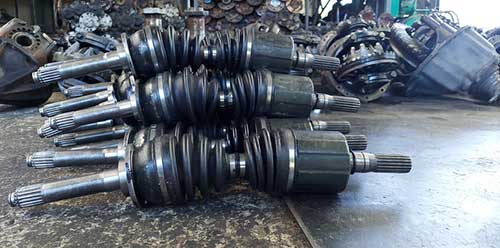Every all-wheel-drive car has an axle shaft on the front side connecting the transmission with the wheels to help drive that vehicle. Available axles must flex to allow a free movement of the suspension up and down.
That makes it possible also for the front wheel to bend the axle either left or right. At the same time, it transmits the driving force from the engine to the wheel. The axle flexes through the help of a driving force known as the drive axle joint or a constant velocity (CV).
The CV Boot is a ribbed rubber flexible boot that prevents water from affecting the joint and the special grease inside the joint.
Inside the joint is a greasy mass, and if you drive the car when the grease is exposed, it will be thrown out by the rotating axle, and the joint becomes contaminated with dirt, sand, water, rocks, and wears out the joint components.
If that continues, you will be forced to replace the entire axle shaft assembly. That is more costly than replacing the CV boots. So it is even better to use a split CV boot which is cheaper and simple to fix, other than driving when the grease is exposed.

A split CV Boot is designed to slide around and cover the axle shaft and join the seam. If you have a leaking CV boot, you can either bolt the seam with some screws or seal it with adhesive tape. However, this is a temporary measure as the split CV boot cannot last as long as the original one.
When the CV joint is well prompted, you can use it for a very long time without replacing it. That is possible if the protective CV joint boot remains undamaged. The only time you will have trouble with the CV joints is when you have cracked CV boot.
As long as the joint is exposed, it will collect dirt, debris, and more and eventually fail because of corrosion and lack of lubrication. The best thing is to have your CV boots inspected regularly to ensure no cracks, tears, or loose CV-boot.
Although the inner CV joint failures are not common, you will know when you have issues because you will notice a vibration or shaking as you speed up. You may also experience clunking when shifting from drive to reserve, or you have been accelerating, and you want to slow down.
Also, CV Split boots are not any good, and even if you install them, you are sure they will crack after some time.
Contents
How Long do Split CV Boots Last?
Split SV may cover a distance of 80000 km or 50000 miles before you have to replace them, and since they are made of rubber, they can withstand friction for a long time. The boots are usually exposed to a lot of heat, but thanks to their resistance, they can still serve you several years before the need to replace them.
Why do My CV Boots Keep Splitting?
Usually, the outer CV joints are more likely to crack than the inner ones because they are exposed to wear and tear because of friction and movement. A small crack can cause a problem with the vehicle because it is usually close to the brakes.
When the grease is exposed, it may contaminate the brakes and affect their performance.
How Do I Stop My CV Boots from Cracking?
Since your CV boots are made of rubber, it is important to take care of the rubber if you want the boots to serve you for long. It would be best to avoid direct heat to the rubber because that will make it brittle and eventually crack. It, therefore, avoids drying them with heat and uses air to dry them.
How can I Make My CV Boots Last Longer?
You need to check your boots after covering a distance of 40000 to 60000 kilometers or 25000 to 37000 miles. It is also important to remove your driveshaft and replace them after covering this distance.
Checking your boots and replacing the driveshaft goes a long way to ensure the CV boot serves you for long. As long as you are taking good care of your boots, they can serve you throughout the life span of your car.
How often should cv boots be replaced?
When you notice a problem before it becomes worse, you should replace the CV joint boots and the CV joints with grease. Before the crackling becomes a problem, that is all that you need. Replacing your CV boots should be done as soon as you notice a problem.
Conclusion
Note that as long as your cv boot is cracked, you must replace them immediately. If you drive for a long time without replacing, the next thing you will notice is the broken boots. Once they break, they will spill out the grease and lubricate the joints, leading to friction and shaft wear and tear.
In the end, you will have to replace the entire axle shaft assembly, which will be costly for you.
